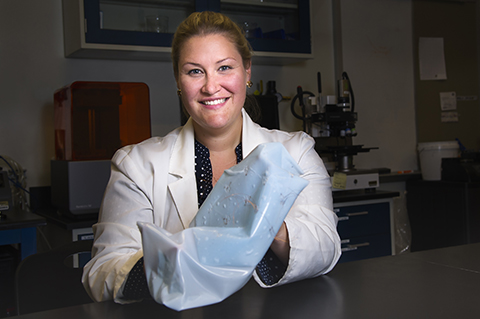September 28, 2016
Purdue Profiles: Rebecca Kramer
 Rebecca Kramer, assistant professor of mechanical engineering, is helping NASA develop robots that are more compatible with space travel. (Purdue University photo/Rebecca Wilcox)
Download image
Rebecca Kramer, assistant professor of mechanical engineering, is helping NASA develop robots that are more compatible with space travel. (Purdue University photo/Rebecca Wilcox)
Download image
Rebecca Kramer is an assistant professor of mechanical engineering at Purdue and she is helping NASA develop robots that are more compatible with space travel.
She has a bachelor's degree in mechanical engineering from Johns Hopkins University, a master's in the same field from the University of California, Berkeley, and a doctorate in engineering science from Harvard University. She specializes in the area of soft robotics.
What is soft robotics and why is it important?
Soft robots are exactly what they sound like -- robots made of soft materials. As advanced as modern machines are, the building blocks have changed little since the Industrial Revolution. Structures, motors and gears are typically rigid, bulky and heavy. In contrast, soft robots offer the compliance and low-weight necessary to make them safe for working in close proximity to humans, as well as allowing them to squeeze into tight spaces, handle fragile objects and be robust in collisions. The combination of elastically deformable materials with soft actuators and sensors will allow a robot to be folded or compressed and placed into a volume much smaller than its deployed size, making transportation easier.
However, the science of soft robotics in still in its infancy. Best practices for distributing actuation and sensing, estimating system state with non-linear material behaviors, and determining the trade-offs between stiffness, precision and force production have not yet been formalized or evaluated. My research program addresses these critical areas by pursuing innovation at the intersection of manufacturing, materials and robotics.
What work are you conducting with NASA?
The robots my students and I are developing are based on soft, highly deformable materials with equally deformable actuators and sensors, which will produce structures that are compactible and deployable. Our work with NASA focuses on planar robotic substrates, such as elastomer skins and fabrics, that are especially advantageous for space travel, where both transportation space and weight should be reduced.
Robotic substrates will enable a new class of ultra-lightweight, low-cost and reconfigurable inflatable or foam-based robots that are well-suited to planetary exploration. The flexible components will be less sensitive to vibrations, making soft robots more resilient and rendering them less sensitive to stressing mission environments. We’re also collaborating with NASA researchers to integrate multifunctional materials into existing NASA robots, such as Super Ball Bot, as well as developing sensory skins that could be integrated into spacesuits and Robonaut.
How did you become interested in this field of study?
I am fortunate to have had the opportunity to study across multiple disciplines, and this diverse background that has converged in the form of soft robotics research. I have studied theoretical fluids, micro-fabrication, materials science, and robotics, and this has driven me to approach robotics from a fundamental materials and manufacturing perspective. As robots move out of highly controlled settings into natural dynamic environments, their success will depend upon innovations in soft and compliant structures, sensors and actuators. My group is uniquely positioned to integrate developments from material science into adaptive robotic systems that will be able to address challenges beyond the scope of today’s technology.
What are some memorable moments from your work?
There have been many highlights in my career so far. However, I love working with students and the successes of my students are always the most memorable. When my students make exciting research breakthroughs, get publications accepted, and win awards that are commensurate with their talents and efforts, these are the moments in which everything seems worth it.
Writer: Megan Huckaby, mhuckaby@purdue.edu, 765-496-1325

